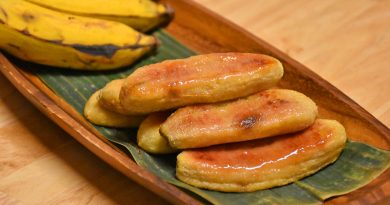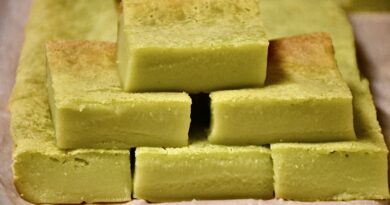Bua Loy
Bua Loy, literally translates to floating lotus. And one can see where this dessert got its name when you see the glutinous rice balls floating in the sweetened coconut milk. It’s chewy with subtle flavors. Similar to mochi balls, except that they have been boiled and steeped in sweetened coconut milk. Though this dessert may be simple, there is quite a bit of versatility because you can customize the colors and flavors of the bua loy. Some folks that I know have even touted having an all natural/ semi-organic bua loy because of the purees they used.
Not only can bua loy be a complete dessert on their own, you may recognize them as the chewy balls in nam wan. Remember a while back, I said I can probably do a whole series on components of nam wan? I believe it was when I made the tuptim (rubies), which I had made green and called them morakot (emerald). Well you really can make a nam wan series and bua loy can be added to that series.
Like many of the other components of nam wan, bua loy is fairly simple and straight forward. It’s when you make all these simple components and put them together that adds complexity to the nam wan dessert. But that’s a thought for another time. Today is bua loy only.
While I was editing the video, I was thinking to myself, I can probably add a dash of pumpkin spice to the flour next time I make the pumpkin version and that would add something different (and yet the same). Hello, pumpkin spice bua loy! One other thing about the pumpkin version, you may want to steam or boil fresh pumpkin rather than use canned pumpkin there. The nuances of the ingredients you use seem to be amplified in the bua loy and you don’t want canny flavors.

For the colorful version, I split the recipe in thirds and used 1/2 cup of glutinous flour with about 1/4 cup of each puree or juice. Add a tablespoon or two of puree if needed to bring the dough together.
Here are a few notes:
- The ratio – the ratio between glutinous rice flour and puree is about 2:1. But what I’ve found was that if the dough is slightly on the wetter side, it produces softer rice balls. Bua loy made with juices tend to be chewier, but as mentioned, if you add a little bit more juice and make a softer dough, you’ll get a softer ball. However remember, softer dough may mean you may not get perfectly round balls because they don’t keep the shape. But if I had to choose between looks and taste, I’d go for the taste any day. They’ll be submerged anyway.

- Flavors – more traditional flavors are pandan, taro and pumpkin, but let your fruit bowl/fridge be the limit. Anything you can blend up or puree, you can turn into bua loy. These purple ones are made from frozen berries that I blended up. Another popular juice to use for the red is beet juice, but you can use anything from strawberries to pomegranate juice.

- For the sweetened coconut milk, the pandan leaf is preferred, but not required. The dessert is made so much better by it though. But you technically don’t even need the coconut milk…period. In various parts of Southeast Asia, you can find bua loy nam king, which is the glutinous rice balls (mochi) in ginger syrup. The syrup is just a simple syrup of sugar, water, fresh ginger and of course, pandan.
- Oh! And the sugar – use whatever sugar you want; palm sugar, brown sugar or even granulated white sugar, but just remember when you are tasting the sweetened coconut milk when it’s warm, it is actually sweeter than that once it cools. So go easy with the sugar unless you just like it sweet.
Bua Loy
Serves: 4-6 servings
Time: 30 minutes
1 ½ cup glutinous rice flour (green bag)
¾ cup taro puree (1 -2 taro and ¼ – ½ cup water – see instructions below) – **can use any other puree**
Sweetened Coconut Milk
1 (13.5 oz) can coconut milk
½ cup palm sugar (preferred) or light brown sugar
½ teaspoon salt
Pandan leaf
Make sweetened coconut milk by combining coconut milk, sugar and salt in a small sauce pan. Add pandan leaf. Bring to boil. Turn off and remove from heat. Allow to cool.
To prepare your puree – This one is for taro. Peel, wash and cut taro into cubes. Boil for 10-15 minutes or until fork tender. Allow to cool slightly before placing in blender and with about ¼ to ½ cup or water and blend until smooth. If you can eat it raw like berries, then you don’t have to cook it before pureeing.

In large bowl, mix flour and puree until dough comes together and forms a ball. Pinch small pieces from the dough and form small round dough balls. Drop a few dough balls into boiling water. They are cooked when they float to the top. Remove from boiling water with slotted spoon. Place in bowl with ice water.
Serve at room temperature with sweetened coconut milk.
Enjoy!
Discover more from Crafts to Crumbs
Subscribe to get the latest posts sent to your email.



